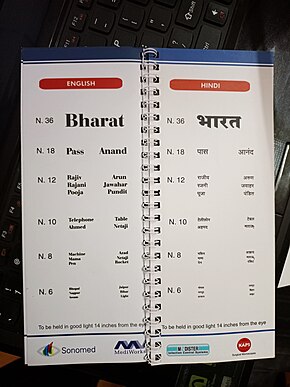Near visual acuity
| Near visual acuity | |
|---|---|
 N notation reading chart in English and Hindi languages |
Near visual acuity or Near vision is a measure of how clearly a person can see nearby small objects or letters. Near vision is usually measured and recorded using a printed hand-held card containing different sized paragraphs, words, letters or symbols. Jaeger chart, N notation reading chart and Snellen's near vision test are the commonly used charts for measuring and recording near visual acuity. Near vision testing is usually done after correcting the distance vision.
Eye conditions like presbyopia, accommodative insufficiency, cycloplegia etc. can affect the near visual acuity.
Physiology of near vision[edit]

In human, near vision is obtained by a mechanism called accommodation. With the help of accommodation, a normal young human eye can change focus from distance (infinity) to as near as 6.5 cm from the eye.[2][3] This change in focal power of the eye of approximately 15 diopters (the reciprocal of focal length in meters) occurs as a consequence of a reduction in zonular tension induced by ciliary muscle contraction. This process can occur in as little as 224 ± 30 milliseconds in bright light.[4]
The amplitude of accommodation declines with age. The dependency of accommodation amplitude on age is graphically summarized by Duane's classical curves.[1]
Factors affecting near vision[edit]
Presbyopia[edit]
Presbyopia is physiological insufficiency of accommodation associated with the aging of the eye that results in defective near vision.[5] Management of presbyopia includes corrective glasses such as a special pair of reading glasses, contact lenses, bifocals, or progressive lenses.[6]
Insufficiency of accommoation[edit]
Insufficiency of accommoation also known as Accommodative insufficiency is another condition that causes blurring of the near vision.[7] Management of accommodative insufficiency needs correcting any underlying refractive errors.[7] Vision therapy may also help improving the condition.[7]
Cycloplegia[edit]
Cycloplegia is the paralysis of the ciliary muscle causing paralysis of accommodation and defective near vision.[8] Cycloplegia can be caused intentionally by instilling some medications into the eyes, or it can occur due to some neurological disorders, or trauma to the eye.[9]
Hypermetropia[edit]
Hypermetropia, the most common refractive error in childhood, affects the near vision more than distant vision.[10]
Tests for near vision[edit]
To measure near vision, a patient is seated in a well illuminated room is asked to read the handheld near vision chart kept at a distance of 25–35 cm away from the eye.[11] The distance used for near vision testing may vary depending on the occupation or basic need of the patient.[12] The smallest test type that the patient can read is the measure of his near acuity. Commonly used tests for near vision are described below.
Jaeger chart[edit]
The Jaeger chart is a card on which paragraphs of text are printed, with the text sizes increasing from 0.37 mm to 2.5 mm.[13] This card is to be held by a patient at a fixed distance from the eye dependent on the J size being read. The smallest print that the patient can read determines their near visual acuity.[14]
Roman test types[edit]
Roman test types also known as N notation reading charts or Point chart,[15] uses Times New Roman font, and records near visual acuity as N5, N6, N8, N10, etc.[11] N notation is the standard near vision test in the United Kingdom and Australia.[16]
M-scale notation[edit]
The M-scale indicate the distance in metres at which the height of a lower case 'x' letter subtends a visual angle of 5 minutes of arc at the nodal point of the eye.[16] The M system is said to have sufficient advantages over other systems for near vision testing to make it a universally accepted standard method.[17] M-scale notation is widely used in North America.[16]
Snellen's near vision test[edit]

Snellen's near vision test is a near vision chart introduced by Dutch ophthalmologist Herman Snellen, which uses the same principle of his distance vision Snellen chart.[11] Size of Snellen's near vision chart is approximately 1/17th of the normal Snellen chart.[11]
Conversion[edit]
| Roman | Jaeger | Snellen (US) |
Snellen (Metric) |
Decimal | M unit |
|---|---|---|---|---|---|
| N4.5 | J1 | 20/20 | 6/6 | 1.00 | 0.5 |
| N5 | J3 | 20/30 | 6/9 | 0.67 | 0.8 |
| N6 | J5 | 20/40 | 6/12 | 0.50 | 1.0 |
| N8 | J6 | 20/50 | 6/15 | 0.40 | - |
| N10 | J7 | 20/60 | 6/18 | 0.33 | 1.2 |
| N12 | J9 | 20/80 | 6/24 | 0.25 | - |
| N14 | J10 | 20/100 | 6/30 | 0.20 | 1.3 |
References[edit]
- ^ a b Duane, Alexander (1922). "Studies in Monocular and Binocular Accommodation with their Clinical Applications". American Journal of Ophthalmology. 5 (11): 865–877. doi:10.1016/s0002-9394(22)90793-7. S2CID 43172462.
- ^ Chen, Ai Hong; O'Leary, Daniel J.; Howell, Edwin R. (2000). "Near visual function in young children". Ophthalmic & Physiological Optics. 20 (3): 185–198. doi:10.1016/S0275-5408(99)00056-3, Fig. 5.
{{cite journal}}: CS1 maint: postscript (link) - ^ That value follows from the maximum accommodative power and can be calculated as 100 cm/15 dpt.
- ^ Lockhart, T. E.; Shi, W. (2010). "Effects of Age on Dynamic Accommodation". Ergonomics. 53 (7): 892–903. doi:10.1080/00140139.2010.489968. PMC 2908311. PMID 20582770.
- ^ Khurana, AK (September 2008). "Asthenopia, anomalies of accommodation and convergence". Theory and practice of optics and refraction (2nd ed.). Elsevier. pp. 100–107. ISBN 978-81-312-1132-8.
- ^ "Presbyopia - EyeWiki". eyewiki.aao.org.
- ^ a b c Enaholo, Ehimare S.; Musa, Mutali J.; Zeppieri, Marco (2024). "Accommodative Insufficiency". StatPearls. StatPearls Publishing.
- ^ Kaur, Kirandeep; Gurnani, Bharat (2024). "Cycloplegic and Noncycloplegic Refraction". StatPearls. StatPearls Publishing.
- ^ "Cycloplegia: The Eye Condition That Affects Your Ability to Focus Up Close".
- ^ Majumdar, Soumyadeep; Tripathy, Koushik (2024). "Hyperopia". StatPearls. StatPearls Publishing.
- ^ a b c d Khurana (2008). Theory and Practice of Optics and Refraction. Elsevier India. p. 49. ISBN 9788131211328.
- ^ Caltrider, David; Gupta, Abhishek; Tripathy, Koushik (2024). "Evaluation of Visual Acuity". StatPearls. StatPearls Publishing.
- ^ Blesi, Michelle; Wise, Barbara; Kelley-Arney, Cathy (2011). Medical Assisting Administrative and Clinical Competencies. Cengage Learning. pp. 888–890. ISBN 978-1133706960.
- ^ G.K. & Pal; Pal; Pravati (1 February 2006). Textbook Of Practical Physiology (2nd ed.). Orient Blackswan. pp. 328–. ISBN 978-81-250-2904-5.
- ^ Houf, James W. (October 2009). "Understanding Near Vision Eye Tests". The American Society for Nondestructive Testing. 8 (4).
- ^ a b c ELLIOTT, DAVID B (2007). Clinical Procedures in Primary Eye Care (3 ed.). Elsevier. pp. 38–41. ISBN 9780750688963.
- ^ Jose, R. T.; Atcherson, R. M. (September 1977). "Type-size variability for near-point acuity tests". American Journal of Optometry and Physiological Optics. 54 (9): 634–638. ISSN 0093-7002.
- ^ "Near visual acuity conversion chart" (PDF). UK Civil Aviation Authority.
- ^ "Print Comparison of Font Sizes". Teaching Students with Visual Impairments.
